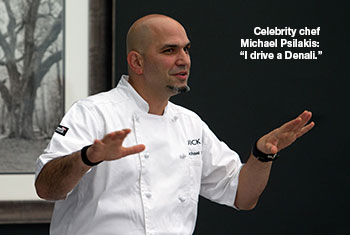After a recent Buick drive in northern Michigan, I kicked back with celebrity chef Michael Psilakis for a couple of cold ones and our chat about New York food trends eventually comes back around to cars, so I ask the restaurateur what he drives.
“A Denali,” he replies. It takes a couple extra questions to find out that he, in fact, owns a Yukon Denali SUV.
GMC marketing executive Roger McCormack says Psilakis isn’t alone. Many owners of GMC products with the toney trim refer to their trucks by Denali rather than the brand or nameplate, reflecting an intense pride-in-ownership. It’s the sort of brand enthusiasm automotive marketers such as McCormack do backflips over.
Sales of Denali-trim products are surging, too. Since its introduction as the ultimate-luxury GMC in 1999, more than 625,000 have been sold. The trim level outsells the entire product lines of some other luxury brands in the U.S., such as Land Rover, Jaguar and Porsche.
 Last year, the GMC brand delivered 450,901 units in the U.S., up 8.9% and underpinned by year-over gains by all models except the Savana large van, according to WardsAuto data. Of those sales, 20% were Denali models.
Last year, the GMC brand delivered 450,901 units in the U.S., up 8.9% and underpinned by year-over gains by all models except the Savana large van, according to WardsAuto data. Of those sales, 20% were Denali models.
The luxury trucks are awfully profitable, too.
“We’ve got some great things happening on (truck) ATPs, at GMC in particular,” Mark Reuss, GM’s product development chief tells WardsAuto.
GM sources say GMC products sell for anywhere between $2,000 and $8,000 more than an average competitor, depending on the segment. Denali-outfitted models command an even steeper premium, with the Sierra Denali Heavy Duty pickup and Yukon Denali large SUV seeing particularly high transaction prices on the strength of specialized content such as a unique instrument cluster and throaty 402-hp 6.2L V-8 engine.
Given the cache of Denali, could it be time to break the trim level off into its own brand? McCormack admits those discussions have occurred at GM’s Renaissance Center headquarters in Detroit, “But we like it where it is now,” he says.
“Denali remains very organic and we’ll get more specific with the Denali marketing message soon, amp it up a bit,” he says during a drive of the redesigned ’15 Sierra Denali HD pickup.
 The Sierra Denali HD underscores the power of that trim line. The model accounts for 25% of Sierra HD sales and the buyer demographic skews greatly toward younger, married males with college degrees working in high-income professional jobs. Again, the sort of customer marketers would lie in the street for.
The Sierra Denali HD underscores the power of that trim line. The model accounts for 25% of Sierra HD sales and the buyer demographic skews greatly toward younger, married males with college degrees working in high-income professional jobs. Again, the sort of customer marketers would lie in the street for.
But busting off Denali into its own brand likely would cause a messy overlap of product, and revisit the badge-engineering that watered down GM products prior to its 2009 bankruptcy and reorganization. That’s why such talk hasn’t gotten any farther than the water cooler.
GM, however, could choose to go heavier on the Denali badging. It already replaces the GMC logo on the steering wheel, graces headrests and sill plates, and rises with drama on the color touchscreen of the infotainment center when the ignition turns over.
Why not strip GMC off the grille, too, and replace it with the Denali script?
There’s precedence for that at Ford, where the automaker responded to buyers who emphasize the Flex name over the Ford brand. The big CUV, which sells in low volumes but boasts a devoted following, has discontinued featuring the Blue Oval badge on its grille in favor of Flex script across the hood lip.
“We don’t have any plans to go that far,” McCormack says, “but never say never.
Because if there’s a volume-selling name that could pull that off right now it’s Denali. Just ask their owners.



